Playing around in the cryptocurrency circle is essentially a contest between retail investors and large players. If you do not have advanced information or first-hand data, you can only be cut! If you want to layout and harvest together with the big players, feel free to follow me. Welcome like-minded people in the cryptocurrency circle to discuss together~
Contract MACD practical formula:
1. If the MACD is above the zero axis, each time a golden cross occurs, the cryptocurrency price is about to set a new high.
2. If the MACD is below the zero axis, each time a death cross occurs, the cryptocurrency price is about to set a new low.
3. MACD golden cross below the zero axis belongs to a rebound in a downward trend, participating only until above the zero axis.
4. MACD golden cross above the zero axis belongs to an upward trend bullish market, allowing for high sell-low buy until top divergence occurs. MACD selling small, cryptocurrency price rising, and the subsequent wave of red columns not reaching the previous high will lead to a decline.
6. MACD sells small, cryptocurrency price falls or stabilizes, and the subsequent wave of green columns does not reach the previous low, will rise.
7. MACD high-level contraction: After a sharp increase in the cryptocurrency price, the MACD moves far from the zero axis, and the red columns shorten quickly, indicating a need to exit quickly.
8. MACD low-level golden cross: After a sharp drop in cryptocurrency prices, when the MACD moves far from the zero axis, it must rise, and a second golden cross will lead to an even stronger upward movement.
9. MACD golden pit: After a wave of price increase, a pullback occurs, and within 7 days after the MACD death cross, the green column is short, followed by a golden cross, and it rises.
The role of the MACD indicator in technical analysis is particularly special and can be said to be an essential part of learning technical analysis. Its importance includes at least the following points.
1. The MACD indicator is the most effective technical indicator tested by historical trends and is also the most widely used indicator.
2. The MACD indicator is derived from the EMA moving average indicator and has good application effects for grasping trending markets. Trend investors generally refer to this indicator in practice.
3. The top and bottom divergence of the MACD indicator is recognized as the best method for 'bottom-fishing and peak-escaping,' and this method is an important tool for concretizing trend theory and wave theory.
4. Many veterans have had the experience: starting to learn the MACD indicator when just entering the field, then slowly discarding it, and after a long period of study and comparison, especially after practical testing, ultimately returning to the MACD indicator. This shows the uniqueness of the indicator.
5. The application of the MACD indicator in quantitative trading is also very extensive.
These advantages have made the MACD indicator the most commonly used technical indicator among professional traders.
Concept and algorithm of the MACD indicator
The MACD indicator, also known as the Exponential Moving Average Convergence Divergence indicator, was created by Gerald Appel to track price trends and analyze candlestick trading opportunities. This indicator is commonly used in trading software and is known as the 'king of indicators.' As shown in [Figure 1].
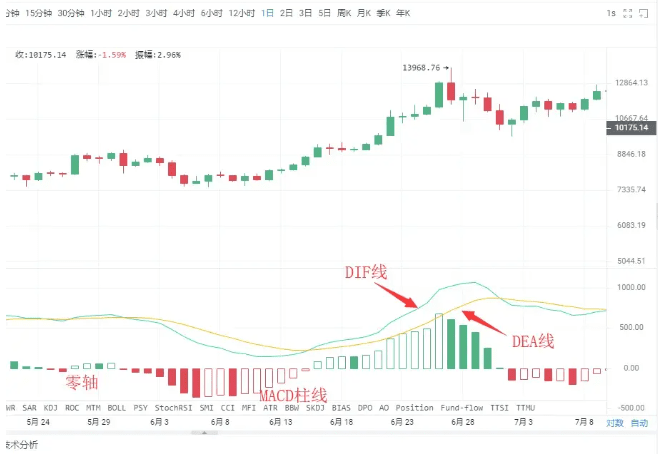
The MACD indicator in the cryptocurrency circle consists of the DIF fast line, DEA slow line, MACD histogram, and zero axis, known as the 'three lines and one axis.' Investors assess prices through the crossing, divergence, breakthroughs, support, and resistance of these 'three lines and one axis.' The MACD indicator has become a preferred indicator in many trading software, indicating its wide application, and also indirectly showing that the indicator is one of the most effective and practical indicators validated by history.
The golden cross and death cross of the MACD
'Golden cross' patterns and 'death cross' patterns are extremely important shapes in technical indicator analysis. The golden cross pattern, also known as the golden crossover, refers to the indicator line of a relatively short period crossing upwards and crossing the indicator line of a relatively longer period (of the same type), often indicating the emergence of short-term buying opportunities. If the golden cross pattern appears after (1) a short-term rapid decline during a downtrend; (2) after a wave of pullback during an uptrend; (3) after a consolidation trend during an uptrend, that is, when the golden cross pattern appears at a phase low, it is a more reliable buy signal.
The death cross pattern, also known as the death crossover, refers to a relatively short-period indicator line crossing downwards and crossing the relatively longer-period indicator line (of the same type), often indicating the emergence of short-term selling opportunities. If the death cross pattern appears after (1) a consolidation trend during a decline; (2) after a rebound during an uptrend; (3) after a short-term rapid rise during an uptrend, that is, when the death cross pattern appears at a phase high, it is a more reliable sell signal.
After understanding the golden cross and death cross patterns, we can specifically look at the MACD indicator line's golden cross and death cross patterns. The appearance of golden and death crosses at different positions reflects different market meanings.
Situation one: Buy point of low-level golden cross
If the position of the DIFF line and DEA line golden cross occurs below the zero axis and is far from the zero axis, this golden cross is called a low-level golden cross. Investors may regard this golden cross only as a short-term price rebound, and whether the candlestick can form a real reversal still needs to be observed and confirmed in conjunction with other indicators.
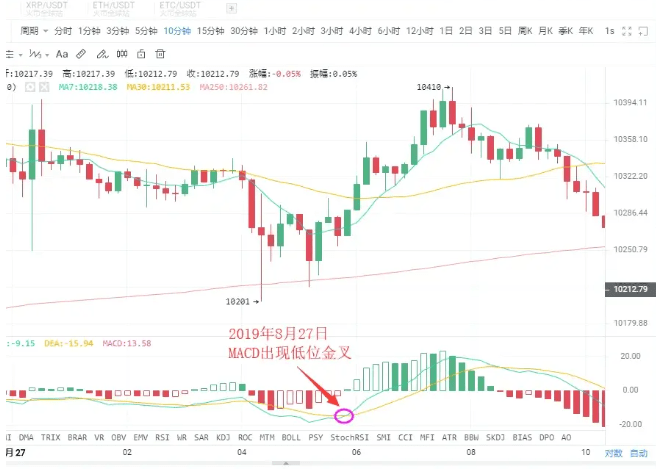
As shown in the figure above:
On August 27, 2019, the BTC 10-minute candlestick chart shows that with the price's pullback, a low-level golden cross appears, followed by a rebound of $200. Short-term investors can seize the opportunity to enter.
Situation two: Buy point of golden cross near the zero axis
If an upward trend has formed, and the golden cross of the DIFF line and DEA line occurs near the zero axis, then it is often an excellent buying opportunity for investors.
This is because, after the upward trend is formed, a golden cross near the zero axis indicates that the adjustment has completely ended, and a new round of upward trend has begun. If it is also accompanied by a golden cross of the average volume line, it indicates that the price increase is supported by trading volume, making the buy signal more reliable.
Once this buying point appears, investors should definitely not miss it, otherwise, they will miss out on a significant upward trend.
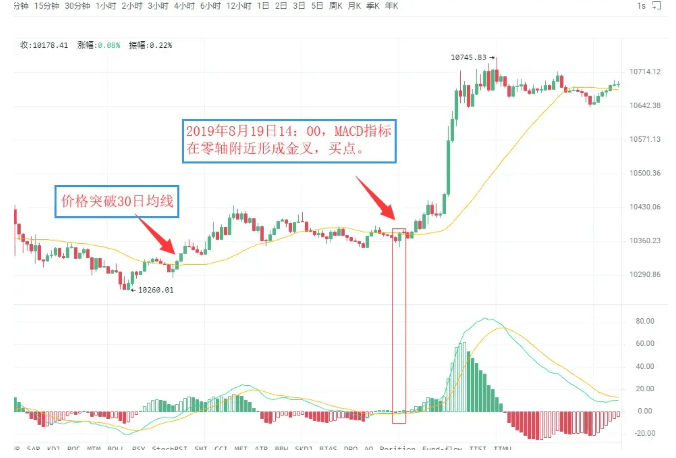
As shown in the figure above:
On August 19, 2019, at 09:30, the BTC 5-minute candlestick chart shows that Bitcoin breaks above the 30-day moving average, indicating that the upward trend has initially formed. For a period afterward, the price remained mostly above the 30-day moving average.
On August 19, 2019, at 14:00, the MACD indicator formed a golden cross near the zero axis, indicating that the market is about to experience a significant upward trend. Investors can buy decisively.
Situation three: Buy point of high-level golden cross
If the golden cross of the DIFF line and DEA line occurs above the zero axis and is at a considerable distance from the zero axis, this golden cross is called a high-level golden cross. High-level golden crosses generally appear during corrective movements in the process of candlestick increases, indicating that the consolidation has ended, and the candlestick is about to continue the previous upward trend. Therefore, once a high-level golden cross appears, it is a good signal for increasing positions.
In practice, when an upward trend is formed, and the candlestick rises slowly and continues for a long time, once the MACD indicator forms a high position golden cross, it often indicates that the candlestick is about to accelerate upward.
Because of this, high-level golden crosses can also be used for wave operations. Investors can utilize the MACD indicator to continuously target upward waves during an upward trend.
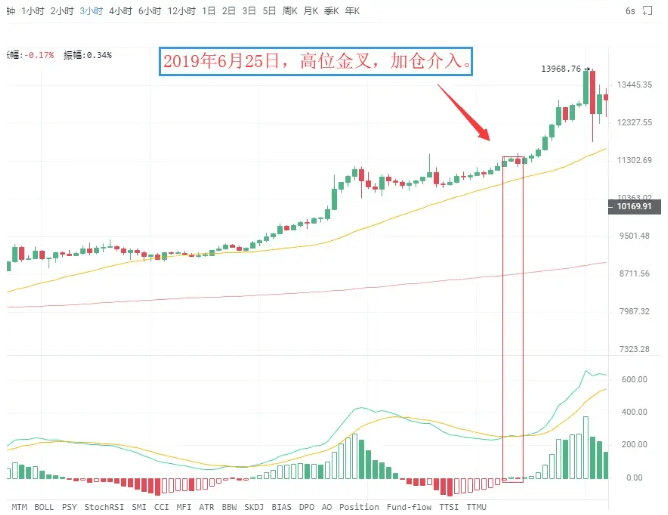
As shown in the figure above:
On June 25, 2019, the BTC 3-hour candlestick chart shows that Bitcoin's price, after consolidating in an upward trend, rises again while the MACD indicator shows a high-level golden cross. It indicates that the pullback has ended, and the price will continue the previous upward trend. Investors should pay attention to seizing this opportunity for additional investment.
Situation four: Sell point of low-level death cross
A low-level death cross refers to a death cross occurring at a considerable distance below the zero axis. This type of low-level death cross often appears when a rebound in a downward trend ends, thus it is a sell signal that the rebound has ended. At this time, investors in the market should pay attention to watch, while those who are deeply trapped can sell first, waiting for the price to drop further to buy back to lower costs.
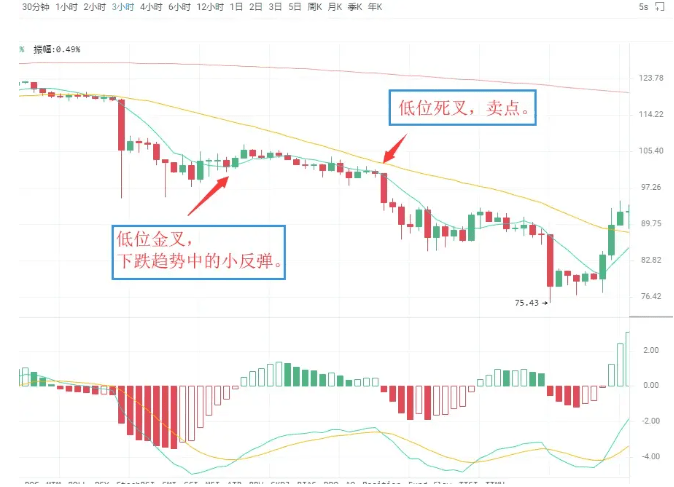
As shown in the figure above:
On July 14, 2019, the 3-hour candlestick chart of LTC shows that the MACD indicator of Litecoin formed a low-level golden cross, and the price experienced a slight rebound, followed by a rapid decline.
Following that, the MACD indicator shows a death cross below the zero axis, and the candlestick begins a new downward trend. Spot investors can sell positions at the death cross, then buy back to reduce holding costs.
Situation five: Sell point of death cross near the zero axis
If the previous market direction has been a downward trend, and at this time the DIFF line crosses below the DEA line near the zero axis, this crossover is called a death cross near the zero axis. It indicates that the market has accumulated a considerable amount of downward momentum near the zero axis, and the appearance of a death cross indicates that the downward momentum of the market is beginning to be released. The candlestick will continue the original downward trend, providing a sell signal.
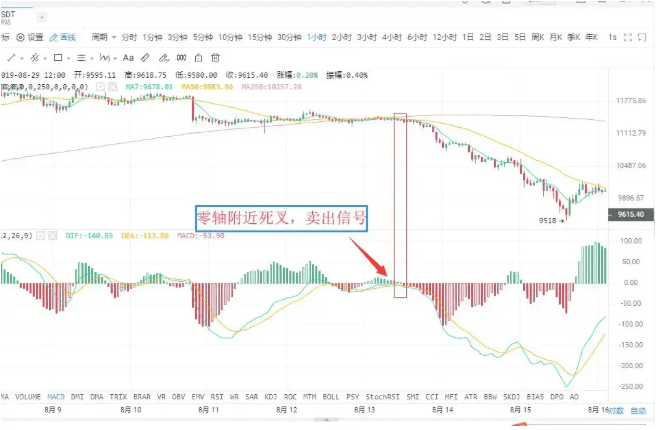
As shown in the figure above:
On August 12, 2019, the BTC 1-hour candlestick chart shows that the DIFF line of Bitcoin breaks below the DEA line near the zero axis forming a death cross. It indicates that the market's downward momentum is beginning to be released, providing a sell signal. Investors should sell decisively, otherwise, they will be deeply trapped.
Situation six: Sell point of high-level death cross
The DIFF line breaking below the DEA line at a distance above the zero axis is called a high-level death cross. This type of death crossover pattern is sometimes accompanied by MACD's top divergence. The manifestation is: during the process of continuous upward movement, the price continuously reaches new highs, but the MACD indicator's DIF line and DEA line no longer continue to rise or break through but deviate from the price trend, gradually moving downwards.
Above the zero axis, when the DIF line crosses below the DEA line, it forms a downward crossover trend, which is a relatively reliable sell signal.
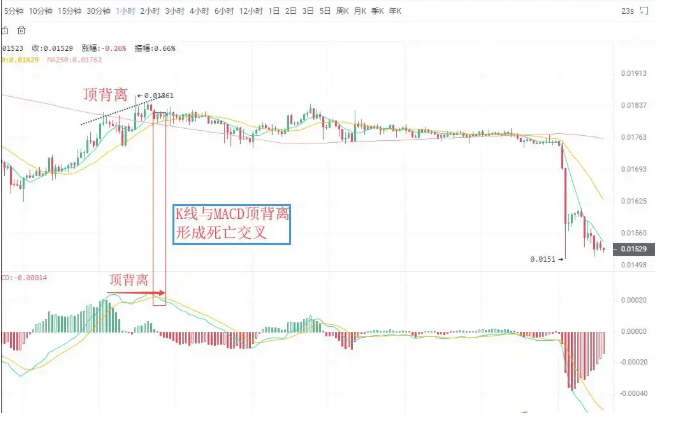
As shown in the figure above:
On August 23, 2019, the 1-hour candlestick chart of TRX shows that after the cryptocurrency price rises for a wave, the price continues to reach new highs, but the DIF line and DEA line no longer continue to rise, and then a death cross forms, signaling a sell.
Divergence between MACD and candlestick
Divergence is a term describing momentum in physics; in technical analysis, it is a widely used and highly successful analysis method. In a downward trend, if the price sets new lows, but the indicator line does not set new lows, it is called bottom divergence, indicating that upward momentum is accumulating, which is a buy signal. In an upward trend, if the price sets new highs, but the indicator line does not set new highs, it is called top divergence, indicating that downward momentum is accumulating, which is a sell signal.
I. Bottom divergence
(1) Bottom divergence of MACD histogram and DIFF line
The bottom divergence between the DIFF line and price refers to when, during a downward trend, the price sets a new low while the DIFF line does not. It indicates that during the price's decline, the decrease of the DIFF line is smaller than that of the price, and upward momentum is continuously accumulating, indicating that the price is about to stop falling, with a higher probability of rising in the next period.
The MACD histogram is the histogram behind the DIFF line, divided into red and green. Its divergence with price is an important use of the MACD indicator and is widely applied in practice. The bottom divergence between the MACD histogram and price refers to when the price continuously sets new lows, while the MACD histogram does not follow to set new lows. The upward momentum in the market is accumulating, and the price is about to stop falling, with a higher probability of rising in the following period.
When a bottom divergence occurs, investors can grasp specific buying points in two ways.
(2) Specific buying timing
The divergence between the DIFF line, MACD histogram, and price is not a specific moment but a pattern that appears over a period. However, when investors buy in, it is a specific moment indicating that the price is about to stop falling. Therefore, to grasp specific buying timing, when the DIFF line, MACD histogram, and candlestick show bottom divergence, investors must combine the bottom divergence with other technical analysis tools to specify the buying point of the bottom divergence.
First: Color change of the histogram or golden cross of the MACD
A color change in the histogram indicates that market upward momentum has begun to gain an advantage. This generally appears after 'histogram shortening.' Although it may be slightly delayed, it is more reliable. When a bottom divergence occurs, if the histogram successfully changes color or forms a golden cross, investors can buy in.
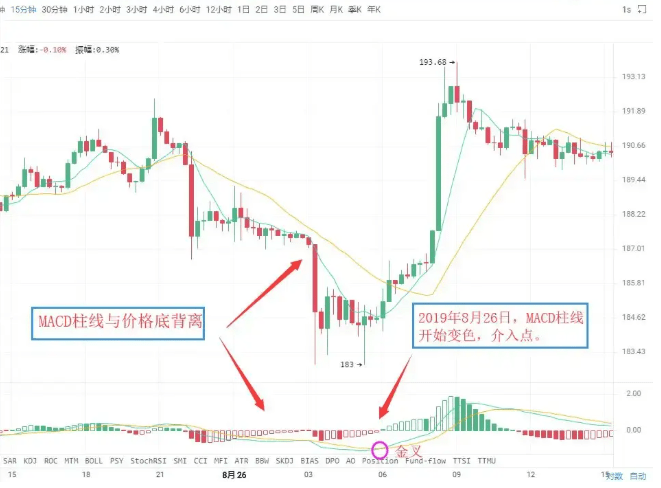
As shown in the figure above:
On August 26, 2019, the 15-minute candlestick chart of Ethereum (ETH) shows that the price of Ethereum set a new low during the decline, but the MACD histogram did not set a new low, forming a bottom divergence pattern between the histogram and the price. It indicates that the market's upward momentum is beginning to accumulate, and there is a high probability that a wave of upward movement will occur.
Following that, the histogram changes color. These two sequential buy signals combined together increase the reliability of upward significance. Investors can intervene when the histogram changes color.
Second: Combine with other technical analysis tools and candlestick reversal patterns
Bottom divergence combined with candlestick reversal patterns, such as 'single needle bottoming' and 'three soldiers at the bottom,' is the concrete application of the 'multi-indicator combination' principle.
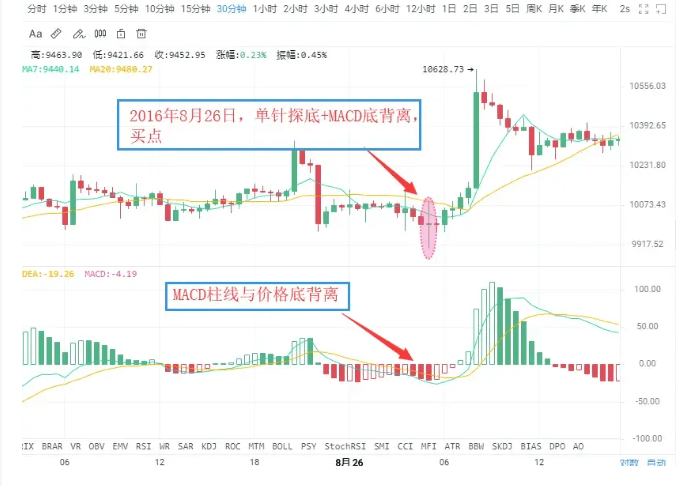
As shown in the figure above:
On August 26, 2016, the BTC 30-minute candlestick chart shows that the price of Bitcoin reaches a new low, but the MACD histogram does not set a new low, forming a bottom divergence pattern between the histogram and the price, indicating the continuous strengthening of the market's upward momentum.
Accompanied by the price's decline and stop, a buying signal of 'MACD histogram and price bottom divergence + candlestick single needle bottoming' forms. Subsequently, the price shows a wave of upward movement.
II. Top divergence
(1) Top divergence of MACD histogram and DIFF line
The top divergence between the MACD histogram and the candlestick refers to when, during an upward trend, the price reaches a new high, but the MACD histogram does not reach a new high. It indicates that the market's downward momentum is accumulating, and the price may drop at any time.
The top divergence between the DIFF line and the candlestick refers to when, during an upward trend, the price sets a new high while the DIFF line does not. It indicates that the market's downward momentum is continuously accumulating, and the price is likely to experience a wave of downward movement next.
(2) Specific sell timing
Similar to bottom divergence, in practice, based on the principle of multi-indicator combination, investors can combine the following methods to make sell signals more specific.
First: Color change of the histogram or death cross of the MACD
After the MACD histogram and the candlestick form a top divergence, if the histogram suddenly shortens significantly, it indicates that the market's downward momentum is beginning to be released. Investors should pay attention to selling in a timely manner. A change in the color of the MACD histogram indicates that the market's downward momentum has gained an advantage, and this generally occurs after the histogram continues to shrink. If after the histogram and candlestick top divergence, a color change in the histogram or a MACD death cross occurs, investors should pay attention to exiting in a timely manner.
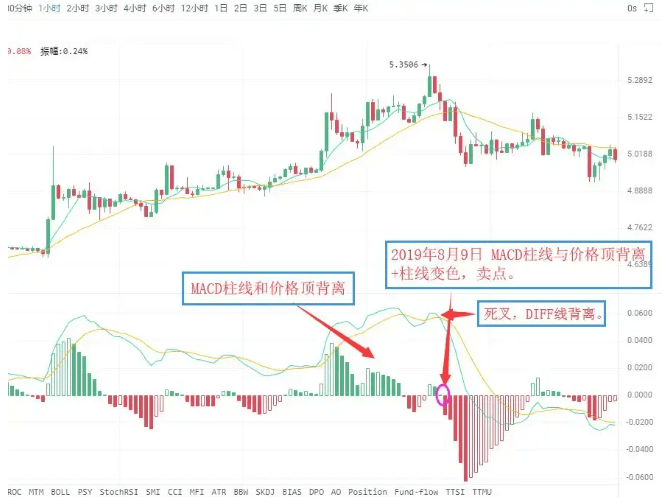
As shown in the figure above:
On August 9, 2019, the HT 1-hour candlestick chart shows that the price of Huobi reaches a new high, but the MACD histogram does not set a new high, forming a top divergence pattern between the histogram and the price. It indicates that the market's downward momentum is continuously accumulating, and the price may experience a wave of downward movement at any time.
Subsequently, the MACD histogram changes from red to green, issuing a sell signal of 'histogram and price top divergence + histogram color change.' Investors should pay attention to exiting in a timely manner.
Second: Combine with other technical analysis tools and candlestick reversal patterns
After the MACD histogram and price form a top divergence, if other technical analysis tools also simultaneously show sell signals, the reliability of the market sell signal will greatly increase. At this time, investors should pay attention to exit decisively. Common sell signals of this type include 'histogram and price top divergence + candlestick reversal pattern', etc.
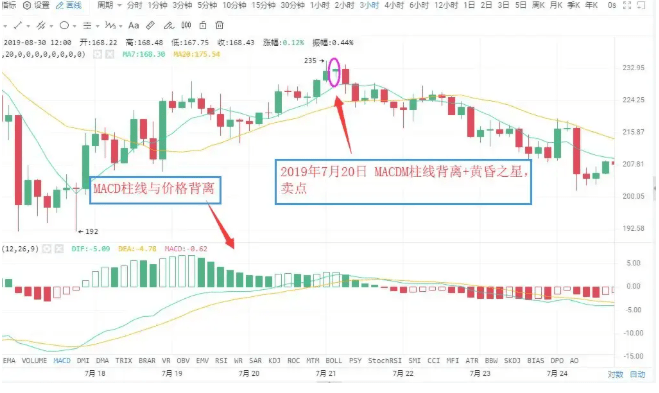
As shown in the figure above:
On July 20, 2019, the ETH 3-hour candlestick chart shows that the price of Ethereum reaches a new high, but the MACD histogram does not set a new high, forming a top divergence pattern between the histogram and the price. It indicates that the market's downward momentum is continuously strengthening, and the price may show a wave of downward movement.
Subsequently, the MACD histogram gradually shortens, while the candlestick forms a shooting star bearish pattern. Investors should pay attention to exiting in a timely manner, as the candlestick then shows a wave of significant downward movement.
Attachment:
Shooting Star: During the rising process of the candlestick, a long bullish candle appears first, followed by a short candlestick (which can be bullish or bearish) the next day. People compare it to a star, which is the main part of the candlestick combination. The third candlestick is a long bearish candle that has penetrated deeply into the body of the first candlestick. A shooting star is a signal of a price peak and retreat, with some predicting an accuracy rate of over 80%.
(Regarding some candlestick patterns of peaks and troughs. We will have several sessions dedicated to this topic later, so please continue to follow us.)
Modification of MACD parameters
The lagging response to price changes sometimes makes buy and sell levels not ideal, which is a flaw of the MACD indicator. One way to change this situation is to adjust the indicator parameters, making the MACD indicator more sensitive to trends, thereby enabling more ideal buy and sell point levels.
In commonly used trading software, the default parameters for the MACD indicator are 12/26/9. Under such parameter settings, the MACD indicator's response to price changes often exhibits significant lag.
The lagging nature of the MACD indicator can be addressed by adjusting parameters. Common parameter combinations include 5/34/5, 5/10/30, etc. Investors can also try and explore more in practice.
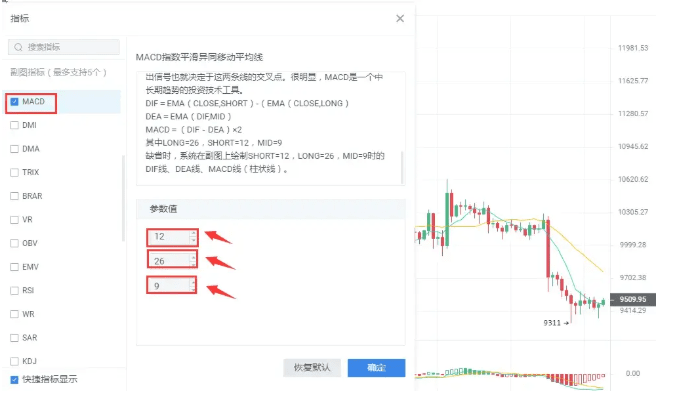
Execution is a hard injury in trading, and holding positions is a common problem in investing. Due to poor execution, no matter how good the strategy is, it cannot be realized. However, due to excessive holding, even the smallest mistakes are magnified, just like a disease that multiplies. When one can no longer hold on and leaves the market, I estimate that no one will say goodbye to you, and even if you have been here, no one will remember you a year later. Any entry cannot be based on luck to hold positions, and any gambling cannot be based on full positions to bet. A single misstep means leaving, while a hundred successes count as success.
I am A Yue, focused on analysis and teaching, a mentor and friend on your investment journey! I wish everyone investing in the market smooth sailing. As an analyst, the most basic thing is to help everyone make money. I solve confusion, trapped positions, and provide operation suggestions, speaking with strength. When you lose direction and don’t know what to do, look to A Yue (homepage) for guidance.
